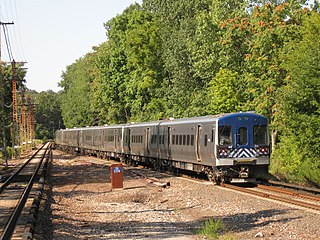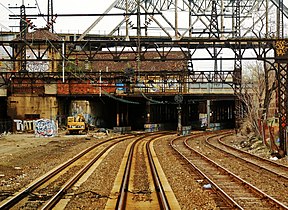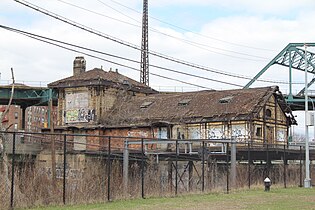
Metro-North Railroad, trading as MTA Metro-North Railroad, is a suburban commuter rail service run by the Metropolitan Transportation Authority (MTA), a public authority of the U.S. state of New York and under contract with the Connecticut Department of Transportation. Metro-North serves the New York Metropolitan Area, running service between New York City and its northern suburbs in New York and Connecticut, including Port Jervis, Spring Valley, Poughkeepsie, Yonkers, New Rochelle, Mount Vernon, White Plains, Southeast and Wassaic in New York and Stamford, New Canaan, Danbury, Bridgeport, Waterbury, and New Haven in Connecticut. Metro-North also provides local rail service within the New York City boroughs of Manhattan and the Bronx. In 2022, the system had a ridership of 52,197,600, or about 189,500 per weekday as of the first quarter of 2023.

The Harlem–125th Street station is a commuter rail stop serving the Metro-North Railroad's Hudson, Harlem, and New Haven Lines. It is located at East 125th Street and Park Avenue in East Harlem, Manhattan, New York City. The station also serves as an important transfer point between the Metro-North trains and the New York City Subway's IRT Lexington Avenue Line for access to the Upper East Side of Manhattan. It is the only station besides Grand Central Terminal that serves all three lines east of the Hudson River. Trains leave for Grand Central Terminal, as well as to the Bronx and the northern suburbs, regularly.

Fordham station, also known as Fordham–East 190th Street station, is a commuter rail stop on the Metro-North Railroad's Harlem and New Haven Lines, serving Fordham Plaza in the Fordham neighborhood of the Bronx, New York City. The platforms are situated just below street level and feature two expanded side platforms that serve eight cars each, on the outer tracks. The station building sits above the tracks on the Fordham Road overpass, and still bears the name New York Central Railroad on its facade. The station is among the busiest rail stations in the Bronx.
The IRT Dyre Avenue Line is a New York City Subway rapid transit line, part of the A Division. It is a branch of the IRT White Plains Road Line in the northeastern section of the Bronx, north of East 180th Street. As of 2013, it has a daily ridership of 34,802.

The Harlem Line is an 82-mile (132 km) commuter rail line owned and operated by the Metro-North Railroad in the U.S. state of New York. It runs north from New York City to Wassaic, in eastern Dutchess County. The lower 53 miles (85 km) from Grand Central Terminal to Southeast, in Putnam County, is electrified with a third rail and has at least two tracks. The section north of Southeast is a non-electrified single-track line served by diesel locomotives. The diesel trains usually run as a shuttle on the northern end of the line, except for rush-hour express trains in the peak direction and one train in each direction on weekends.

The Hudson Line is a commuter rail line owned and operated by the Metro-North Railroad in the U.S. state of New York. It runs north from New York City along the east shore of the Hudson River, terminating at Poughkeepsie. The line was originally the Hudson River Railroad, and eventually became the Hudson Division of the New York Central Railroad. It runs along what was the far southern leg of the Central's famed "Water Level Route" to Chicago.

The Harlem River and Port Chester Railroad (HR&PC) was chartered in 1866 as a branch line railroad between New York City and Port Chester, New York. The line opened in 1873 as part of the New York, New Haven and Hartford Railroad and served in various capacities until 1971. The HR&PC is now part of the Hell Gate Line section of Amtrak's high-speed Northeast Corridor.

Woodlawn station is a commuter rail stop on the Metro-North Railroad's Harlem Line, serving the Woodlawn section of the Bronx, New York City. It is located on East 233rd Street near Webster Avenue. Just north of the station is Woodlawn Junction, where the New Haven Line splits from the Harlem Line to join the Northeast Corridor.

The Morris Park station is a station on the IRT Dyre Avenue Line of the New York City Subway served by the 5 train at all times. It is located at Paulding Avenue and the Esplanade in Morris Park, Bronx.

New Rochelle station is a Metro-North Railroad and Amtrak train station located in New Rochelle, New York. The station serves Metro-North's New Haven Line and Amtrak's Northeast Regional; Bee-Line Bus System buses serve a bus stop just outside the station. As of August 2006, weekday commuter ridership was 4,020, and there are 1,381 parking spots. It is the busiest New Haven Line station in Westchester County.

Port Chester station is a commuter rail stop on the Metro-North Railroad's New Haven Line, located in Port Chester, New York. The station is the northernmost station on the line in New York before crossing into Connecticut.

The New York, Westchester and Boston Railway Company, was an electric commuter railroad in the Bronx and Westchester County, New York from 1912 to 1937. It ran from the southernmost part of the South Bronx, near the Harlem River, to Mount Vernon with branches north to White Plains and east to Port Chester. From 1906, construction and operation was under the control of the New York, New Haven & Hartford Railroad (NH) until its bankruptcy in 1935.
The 129th Street station was a transfer station on the IRT Third Avenue Line in Manhattan, New York City, shared by elevated trains of both the Third Avenue Line and IRT Second Avenue Line. The next stop to the north was 133rd Street for the main line and Willis Avenue for the Willis Avenue spur, both of which were across a swing bridge above the Harlem River in the Bronx. The next stop to the south was 125th Street−Third Avenue for Third Avenue Line trains and 125th Street−Second Avenue for Second Avenue Line trains.
The Willis Avenue station was an elevated rapid transit station of the Willis Avenue Spur that branched off of the IRT Third Avenue Line in the Bronx, New York City. It opened in 1886 and closed in 1924.

Concrete Plant Park is a public park in the Longwood section of the Bronx, New York City. It consists of 7.39 acres (2.99 ha) located on the west bank of the Bronx River between Westchester Avenue and Bruckner Boulevard. The centerpiece and namesake of the park is a group of restored structures from the concrete plant which once occupied its site. It is maintained by the New York City Department of Parks and Recreation.

The Hell Gate Line is the portion of Amtrak's high-speed Northeast Corridor between Harold Interlocking in Sunnyside, Queens and Shell Interlocking in New Rochelle, New York.
Morris Park station is a planned passenger rail station on the Metro-North Railroad New Haven Line, to be located in Morris Park, Bronx. The station is planned to open in 2027 as part of the Penn Station Access project. It will be located at Morris Park Avenue adjacent to the Albert Einstein College of Medicine, with entrances from both sides of the tracks.

Hunts Point station is a planned passenger rail station on the New Haven Line of the Metro-North Railroad New Haven Line, to be located in Hunts Point, Bronx. The station is planned to open in 2027 as part of the Penn Station Access project, which will add four stations in The Bronx. The station will be located north of Hunts Point Avenue, behind the former New York, New Haven and Hartford Railroad station, which was designed by Cass Gilbert.

City Island station, is a former railway station within Pelham Bay Park, along the Hell Gate Line in the Bronx, New York. A larger stone station house was designed for the station by Cass Gilbert and built in 1908, remaining in use up until the 1930s. The station is along what is currently Amtrak's Northeast Corridor.




















